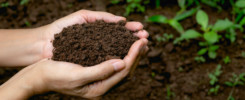 Submitted By: Egan Davis, Principal Instructor (UBC Botanical Garden)
Submitted By: Egan Davis, Principal Instructor (UBC Botanical Garden)
Have you ever been curious about the quality of your soil? By understanding a few general principles, you can make informed decisions about the soil in your garden. In this summary, you will learn about what makes good soil, and why soil health is so important. To read the full article, see here.
What is soil?
From a gardener’s perspective, there are three major types of soils:
- Native soil contains a mix of sand, silt and clay with decomposed organic materials. It provides nutrition and habitat to plants, insects, animals and micro-organisms (small organisms that we can’t see).
- Manufactured soil is sold for landscaping and gardening. In Metro Vancouver, it is usually made of sand and composted organic material. This soil is more likely to become compacted than native soil is, but with a few tricks, you can improve its structure.
- Potting soil is mostly made of organic materials, as well as an ultra-light pumice called ‘perlite’ – this material improves drainage and air space within the soil. Low in nutrients, potting soil is best used for container gardening.
A Note on Urban Gardens
Soil conditions in urban gardens are usually quite poor – a typical urban site may have its native soils replaced with poor-quality construction soil and a shallow layer of manufactured topsoil. As the installed topsoil decomposes and compresses, this layer becomes even shallower. This creates challenging growing conditions for plants, but adding annual mulches of leaves or compost is one solution.
Understanding Soil Quality
Water, Air and Roots
- The physical qualities of soil influence the ability of water, air and roots to move easily through the soil profile.
- A good garden soil should have about 50% pore space, with the rest being solid particles.
- A well-aerated and non-compacted soil supports a healthy ecosystem and creates ideal conditions for plant roots, worms, insects and microbes.
Nutrition
- Nutrients in the soil help plants to photosynthesize, function and grow.
- Nutrients are drawn from the soil through roots and with carbon, become part of plant tissues.
- As plant tissues complete their cycle and decay, microbes break them down, returning materials to the soil and air.
- This system can be mimicked in the garden through composting and mulching practices.
- Not all plants require peak nutritional levels – many plants thrive in the lean soils that they are adapted to.
Biological Health
- Plants, insects, worms, mammals, birds, reptiles, amphibians, fungi, bacteria and other micro-organisms live and feed in soil.
- All of this life is interconnected in the soil matrix as part of a complex and multi-layered food chain – these interactions help plants grow through nutrient cycling and soil mixing.
- All of the physical, chemical and biological factors contributing towards good soil health are interconnected and interdependent.
Link to deep dive



